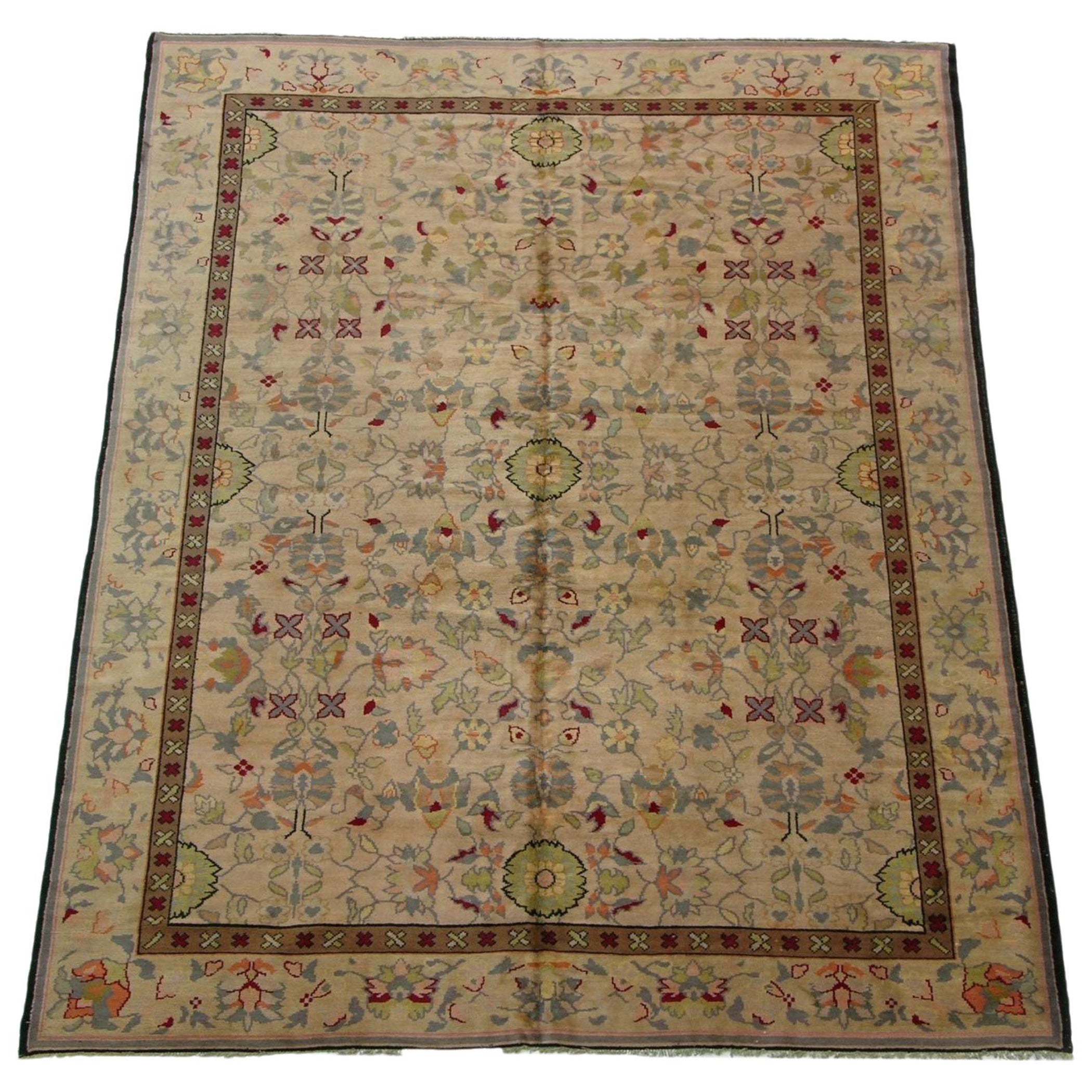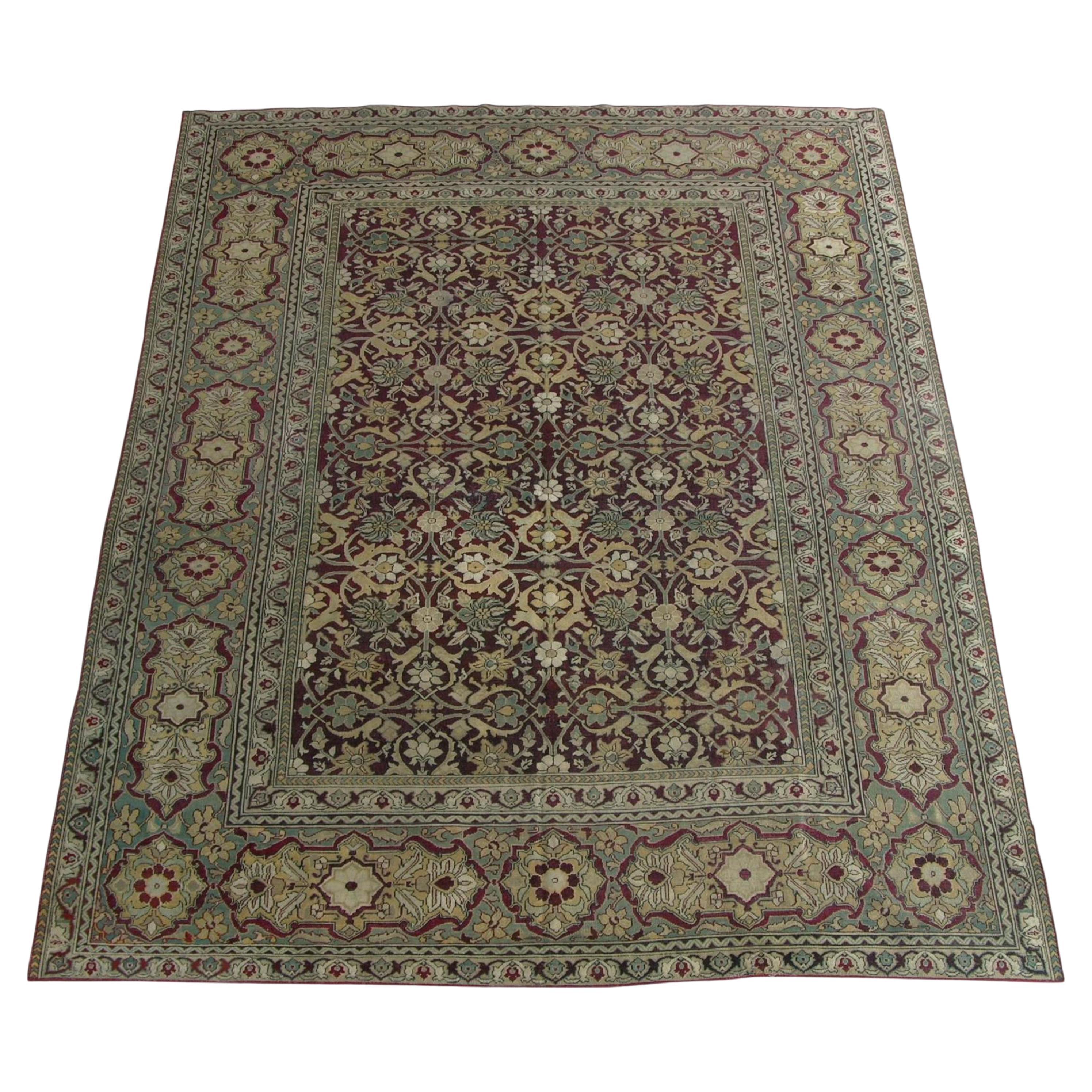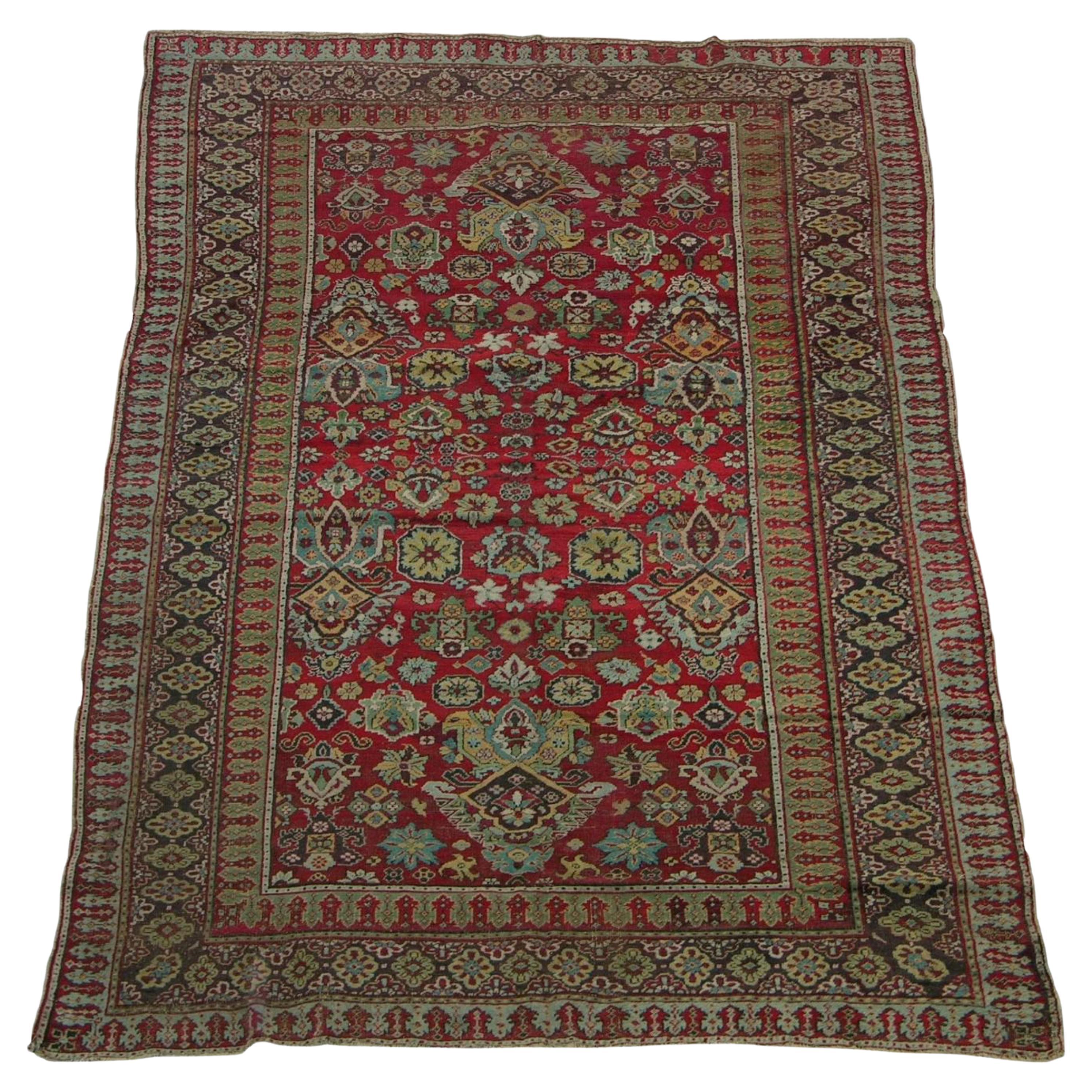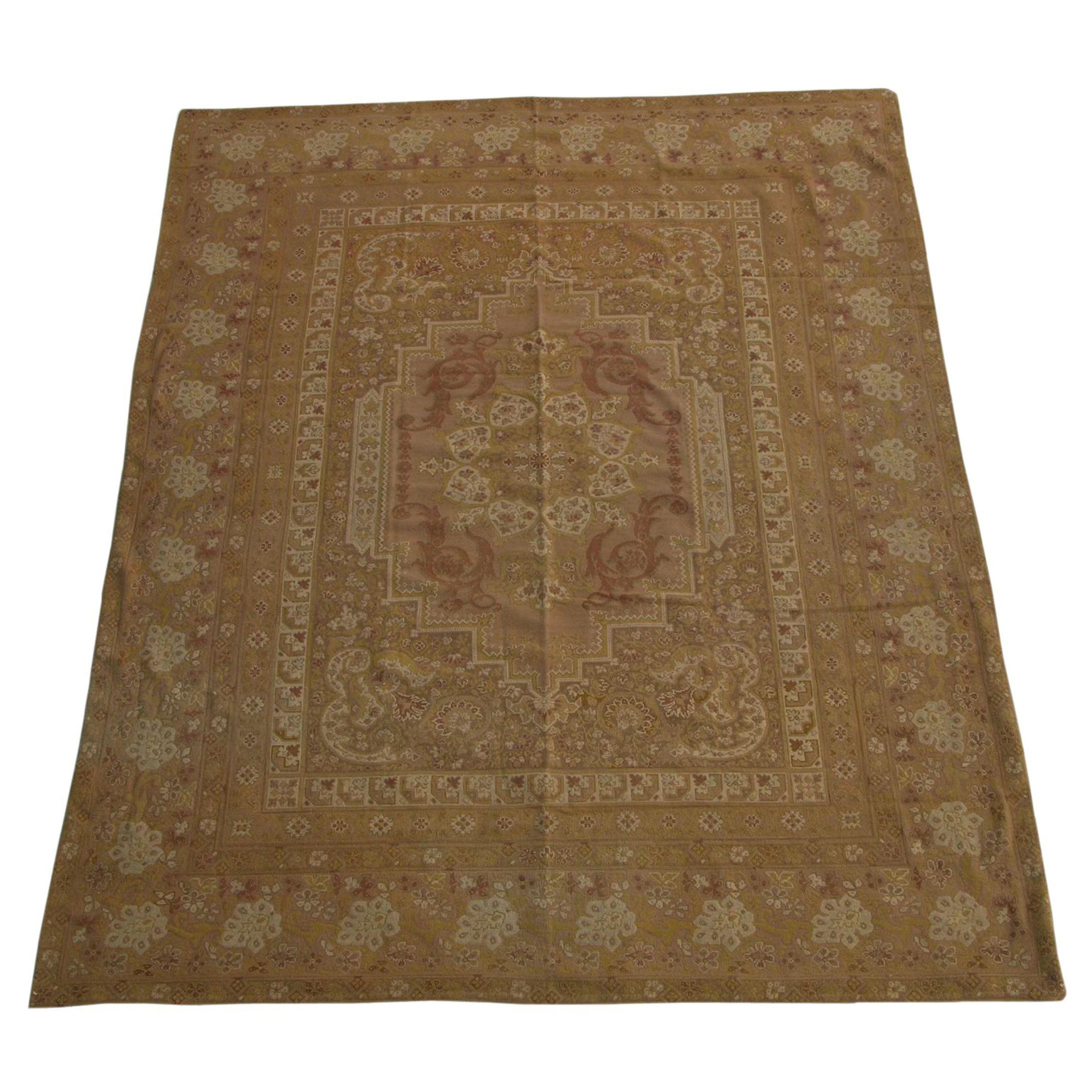Items Similar to 1900s Antique Chinese Small Rug - 7'2'' X 4'5''
Want more images or videos?
Request additional images or videos from the seller
1 of 5
1900s Antique Chinese Small Rug - 7'2'' X 4'5''
About the Item
Antique Chinese Rugs, as opposed to most of the antique rug productions, were woven almost exclusively for internal consumption. Since they were mostly sheltered from European and Western influences, this offers us the reason why these carpets have a very unique truly ethnically Chinese look and appeal. In terms of materials, Chinese rugs are often woven from silk, and other materials like wool or cotton.
The art of knotting and weaving carpets was probably introduced in China somewhere between the 15th and 17th centuries. Some of the patterns in these early carpets were borrowed from those same patterns painted onto porcelain and other Chinese art. These carpets showed up in the imperial courts during their time. Today, it’s incredibly rare to find a Chinese carpet from the 17th or 18th century outside of a museum.
Only during the early part of the 19th century did China open their markets to the countries of the west (for rugs – they have been exporting porcelain, bronzes, wooden and other works of art for many years prior to the 19th century).
It is during this period (the early 1900′s and on) that we see a major and unmistakable change in the production, abandoning the traditional ornamental look to a more open and even Chinese Art Deco design. This shift in production brought with it a more commercial approach to the Chinese rug market with less attention to the quality and artistry of every single piece to more mass appeal look and price. This explains why there are so many of the so called Art Deco Chinese carpets in the market today.
To attain the true essence of Chinese weaving one merely needs to compare the pre-1910 production to the later ones. While the textile industry in China is rich in history and centuries old the earliest surviving examples of the craft are believed to have been produced during the time of Ch’ung Chen, the last emperor of the Ming dynasty who died during the first half of the 17th century.
The Ming dynasty which followed survived until the creation of the Chinese republic in 1912. This would be a good time to note that while most rugs are attributed to a specific manufacturer or region, authorities and scholars attribute the age vintage of any specific rug to the ruling emperor of the time. In stark difference from the other rug weaving origins, in China, the artistic impression far exceeded the importance of the quality of any said piece, the end result being that some of the beautiful pieces have coarser knotting.
Rich in culture, history and folklore Chinese carpets incorporate design almost never seen in any other type of rug. Dragons, local art and ornamental objects are almost always a trademark of these productions. Some of the symbols used in Chinese rugs have taoist and buddhist religious origins.
- Dimensions:Width: 53 in (134.62 cm)Length: 86 in (218.44 cm)
- Style:Other (In the Style Of)
- Materials and Techniques:
- Place of Origin:
- Period:1900-1909
- Date of Manufacture:1900
- Condition:Good Condition.
- Seller Location:Los Angeles, US
- Reference Number:
About the Seller
5.0
Gold Seller
These expertly vetted sellers are highly rated and consistently exceed customer expectations.
Established in 1920
1stDibs seller since 2023
26 sales on 1stDibs
Typical response time: <1 hour
- ShippingRetrieving quote...Ships From: Los Angeles, US
- Return PolicyA return for this item may be initiated within 3 days of delivery.
More From This SellerView All
- 1900s Antique Beige Chinese Rug - 11'4'' X 8'5''Located in Los Angeles, USAntique Chinese Rugs, as opposed to most of the antique rug productions, were woven almost exclusively for internal consumption. Since they were mostly sheltered from European and We...Category
Antique Early 1900s Art Deco Russian and Scandinavian Rugs
MaterialsWool
- 1900s Antique Indian Amritsar RugLocated in Los Angeles, USAntique Amritsar Rugs – The spectacular rugs of Amritsar capture the exotic style of India while incorporating a subtle colonial influence. This convergence of eastern and western styles results in an exceptionally alluring appearance that has been beloved by western consumers historically and today. The outstanding old Amritsar carpets were created by influential exporters to fuel the demand for exotic rugs...Category
Antique Early 1900s Asian Other Russian and Scandinavian Rugs
MaterialsWool, Cotton
- 1900s Antique Indian Amritsar RugLocated in Los Angeles, USAntique Amritsar Rugs: - The spectacular rugs of Amritsar capture the exotic style of India while incorporating a subtle colonial influence. This convergence of eastern and western s...Category
Antique Early 1900s Asian Other Russian and Scandinavian Rugs
MaterialsWool, Cotton
- 1900s Antique French Needlepoint RugLocated in Los Angeles, USNeedlepoint rugs were created using the traditional needlework weaving technique that is used to make everyday items from furniture to carpets and artwork. However, it has a fascinating history both as a hobby and as an industry. When many people think of carpets, they think of pile carpets or flat weave kilims, but needlepoint has also been used to create beautiful carpets. These carpets are durable and an important part of carpet history. Archaeologists and scholars consider the roots of needlepoint to have been around 1500 BC. They consider the first needlepoint to include the fine diagonal stitches that were used to sew tents together by the ancient Egyptians. The art eventually evolved into tapestry weaving. However, a tapestry weaving differs significantly from needlepoint in that it uses a loom and vertical warp. Tapestry weaving is closer to the weaving of kilims and pile rugs than canvas work. However, some still include tapestry weaving in the category of needlepoint because of the fine work that appeared during the late Renaissance. It can have a similar appearance to the untrained eye. Technically, tapestry weaving and needlepoint are not the same, and they do not use the same technique. The first actual needlepoint rugs and needle-points began to appear in the late Renaissance. Needlepoint is worked by creating stitches on a stiff canvas. The canvas is typically made from jute or linen and is quite durable. Pieces from the Renaissance were used to cover footstools, chairs, pillows, bed headboards, and other furnishings. They were also used as table coverings and wall coverings. You could also find them on many small items such as purses, shoes, and various adornments for clothing. During the Renaissance, the craft reached a high level of skill, and the designs became incredibly detailed and realistic. They mimicked many of the subjects and styles of famous paintings of the time. They created florals, still life designs, scenes, and geometric tiled pieces. Some of them mimicked the designs found in Persian Carpets. Needlepoint reached its peak popularity in the 19th century when it was considered a proper occupation for a lady. Needlepoint and embroidery held a similar place in societal status at the time. During this time, the work became finer, with some of the canvas reaching a high level of detail. The level of detail is determined by counting the number of mesh in an inch. During this time petit point by French needlewomen could have a mesh count as high as 45 mesh. This allowed women to create highly intricate designs with incredible levels of detail. It is possible to find many antique pieces of needlepoint besides rugs. Needlepoint rugs were popular in France and Spain, where the technique was adapted to create highly intricate designs that mimicked the designs in architecture and fashion. They were popular because they were durable, and it could be fashioned into a variety of items. The canvases themselves were durable, and the wool that they used was also strong, which means that many of the pieces were able to withstand daily use. We have many artifacts that have survived from this time period. Needlepoint rugs are important collectibles because they are different from the pile rugs and kilims that are typically found on the market. Needlepoint carpets are special because they take many hours to create, especially larger works. Needlepoint pieces of any type became popular throughout Europe during the 19th century. It is still a popular hobby today, but perhaps one of the most interesting stories is that of the Portuguese needlewomen of Arraiolos. The story of these women and their beautiful carpets begins in 1492. Needlepoint was a popular occupation in Spain, which had a large population of Moors and Jews. They were an integral part of Spanish culture. However, in 1492, Queen Isabella of Spain issued a proclamation that gave these ethnic groups the order to pack their bags and board ships headed...Category
Antique Early 1900s Other Russian and Scandinavian Rugs
MaterialsWool, Cotton
- 1900s Antique Khotan Samarkand RugLocated in Los Angeles, USAntique Samarkand Rugs: The desert oasis of Khotan was an important stop on the Silk Road. The people of Khotan were expert carpet weavers who produced high quality antique rugs and ...Category
Antique Early 1900s Other Russian and Scandinavian Rugs
MaterialsWool, Cotton
- 1900s Antique Animal Samarkand RugLocated in Los Angeles, USAntique Samarkand Rugs: The desert oasis of Khotan was an important stop on the Silk Road. The people of Khotan were expert carpet weavers who produced high quality antique rugs and ...Category
Antique Early 1900s Asian Tribal Russian and Scandinavian Rugs
MaterialsWool, Cotton
You May Also Like
- Handmade Antique Caucasian Avar Rug, 1900s, 1p49Located in Bordeaux, FRHandmade antique Caucasian Avar rug from Daghetsan. The rug is in unusual design, from the beginning of 20th century. -condition: good, -circa: 1900s, ...Category
Antique Early 1900s Russian Russian and Scandinavian Rugs
MaterialsWool
- Antique Hand Woven Russian Besserabian Rug, circa 1900sLocated in New York, NYThis southern Russian kilim-tapestry technique carpet shows a golden-tan field with a three echelon pattern of outline cartouches and barbed leaf-forms detailed in sienna, cream and ...Category
Antique Early 1900s Russian Bessarabian Russian and Scandinavian Rugs
MaterialsWool
- Antique Square Bokhara Rug, circa 1890 4'3 x 4'5Located in Secaucus, NJAntique Bokhara Rug, circa 1890. Bokara or Bokhara rugs are named after the city where they were sold. These rugs were made by Turkoman tribes, and these weavers gave the rug its dis...Category
Antique 19th Century Russian Russian and Scandinavian Rugs
MaterialsWool
- Early 20th Century Antique Caucasian Hand Knotted Rug - 4'8" x 7'2"Located in Carlstadt, NJBring life to your home with this fascinating antique carpet. This handcrafted Caucasian Karachopf is an original excellent condition hand knotted oriental rug. This limited piece ha...Category
Antique 1890s Russian Other Russian and Scandinavian Rugs
MaterialsWool
- Antique Russian Chichi, circa 1900sLocated in WEST HOLLYWOOD, CARug Number 17218 Size 3' 5" X 6' 2" Design Chichi Collection Antique/Vintage Material Wool Texture Pile Weave Origin Russia Age Antique/Vintage.Category
Antique Early 1900s Russian Russian and Scandinavian Rugs
MaterialsWool
- Antique Russian Gharabagh Circa 1900sLocated in WEST HOLLYWOOD, CARug Number 28430 Size 3' 8" X 5' 7" Design Gharabagh Collection Antique/Vintage Material Wool Texture Pile Weave Origin Russia Age Antique/VintageCategory
Antique Early 1900s Russian Russian and Scandinavian Rugs
MaterialsWool





